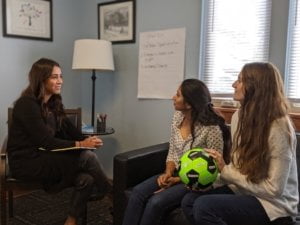From the Desk of Professional Development

For those of you like me, you started watching the COVID-19 news with mixed emotions. Wavering between “do I take this seriously” and “we’ve got to be vigilant”. My answer when we first started talking about COVID-19 was ‘we must protect those who are vulnerable’. Three weeks into social distancing and staying at home — my answer remains the same. We have to do our part to protect both those at-risk for life threatening symptoms from COVID-19, as well as, protecting members of society vulnerable to food insecurity, housing insecurity, and other risk factors that are exacerbated by needed public health safety measures.
As professionals we take a roll of helping others prepare and weed through the disinformation. For at risk youth, we may be the only person who has this conversation with them. That is why having conversations about COVID-19 with youth are so important.
Conversations we’ve been having with Huckleberry House clients focus on preparation, protection, and action.
What does that look like for professionals?
- Read printed guides from CDC, Ohio Department of Health, Columbus Public Health, etc.
- Attend trainings on Telehealth medicine & COVID-19
- Follow up with clients about their access to medical care (both for and not for COVID-19)
- Create a household plan of action for Clients
- Safety plan a safe place to go, if a client cannot stay home
- Review warning signs & important information
Things to help clients:
- List of nearby medical care (Not COVID-19 related)
- COVID-19 Testing Locations near them
- List of programs to help with food
- Telehealth resources
- Activities that youth can do over their extended spring break
- Check out SAMSHA’s Guide for Social Distancing
- Create an emergency contact list including family, friends, neighbors, carpool drivers, healthcare providers, teachers, employers, the local public health department, and other community resources
Know the Signs:
If you think you have COVID-19 or are experiencing any emergency medical symptoms, please seek medical attention IMMEDIATELY.
- *Most common COVID-19 Symptoms:
- Fever
- Cough
- Shortness of Breath
- *Emergency Medical Signs in Adults (Not an exhaustive list):
- Difficulty breathing or shortness of breath
- Persistent chest pain or pressure
- New confusion or inability to arouse
- Blush lips or face
* WebMD reports a normal body temperature range for adults is 97 F to 99 F, while babies and children is 97.9 F to 100.4 F.
More Professional Resources for You:
- CDC website
- Ohio Department of Health
- NASP Guide for Parents on Talking with Youth about COVID-19
- CPH COVID-19 Call Center
- If you are in Columbus/Franklin County and have symptoms of COVID-19, are a homeless service provider with questions about Covid-19, or are concerned about a client, contact 614-645-1519. The call center is open 7 days a week, 7:30-5:30 pm.
- ODH Call Center
- The ODH coronavirus disease 2019 call center can be reached at 1-833-4-ASK-ODH. ODH staffers operate the center seven days a week from 9 a.m. to 8 p.m. daily, including weekends.
- Franklin County Public Health
Download our free My House Plan worksheet to help your clients plan
Includes:
- Prep Steps
- Tips for Staying Healthy & Safe
- Emergency #s
- Medical Info Cards
- Activity Ideas for Youth
Resources
Centers for Disease Control and Prevention (CDC). (2020, March 16). Symptoms. Retrieved from https://www.cdc.gov/coronavirus/2019-ncov/symptoms-testing/symptoms.html?CDC_AA_refVal=https://www.cdc.gov/coronavirus/2019-ncov/about/symptoms.html
Felson, S. (2019, May 15). What is Normal Body Temperature? Low vs. High, Normal Range. Retrieved from https://www.webmd.com/first-aid/normal-body-temperature#1


